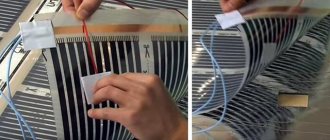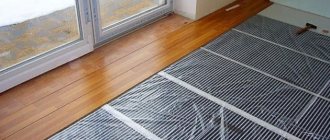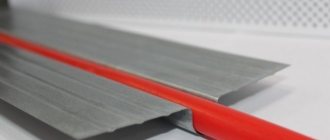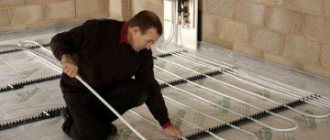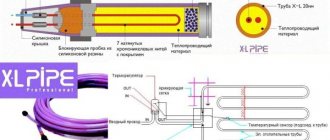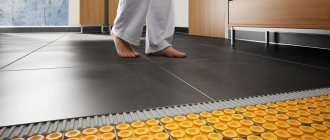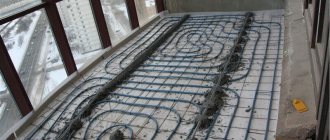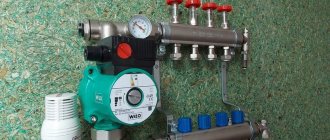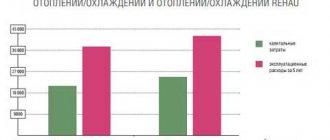Installation and installation of underfloor heating systems requires special skills, knowledge of the technology for performing the work and attentiveness. This applies not only to the process of installing heating elements, but also affects the choice of facing material that will be laid after completion of installation activities.
If the choice of ceramic tiles is quite simple, then before choosing a laminate for a heated floor, you should familiarize yourself with the possibility of laying it and using it in such conditions.
Criteria for choosing a facing coating
Installation of water or electric heating systems for further laying of conventional laminate flooring can result in a lot of problems associated with constant heating of the material to 25-27°C.
When laminate sheets are heated to temperatures above 25 °C, harmful formaldehydes are released, which are used in the resins and binders involved in manufacturing.
The use of conventional laminate up to 25 °C does not pose any harm to human health and others, which has been confirmed by a number of studies. A specialized laminate for heated floors is free from this drawback due to the use of a special manufacturing technology based on reducing the amount of harmful binders.
Markings indicating the possible use of cladding in conjunction with heating systems
The accessory and possibility of installing the laminate over the installed floor heating system is indicated on the packaging and in the installation instructions that come with the material. For most manufacturers, this is evidenced by special markings in the form of a stylized icon indicating a heated floor, spirally arranged heating elements, or an accompanying comment like “Underfloor Heating”.
Next to the marking the recommended type of heating systems and the temperature range in which this material is allowed to be used without any problems is indicated.
From a technical point of view, laminate flooring with heated floors must have a certain thermal conductivity coefficient. According to European standards, the thermal conductivity index for finishing cladding laid above the heating system should be no more than 0.15 m²*K/W.
The value of 0.15 m²*K/W includes the resistance of the laminate used and the substrate used to lay it. For example, a coating with a coefficient of 0.078 m²*K/W and a substrate with a coefficient of 0.066 m²*K/W were purchased. This gives a total of 0.144 m²*K/W, which is quite adequate.
The choice of materials with appropriate thermal conductivity indicators should be approached with complete seriousness, since the further operation of the coating depends on this. If the stated standards are exceeded, there may be a risk of overheating of the floor heating system and damage to the floor cladding.
Coverage class and room type
Stylized icons indicating the presence of certain properties and qualities of the cladding
The class of the laminate directly affects its quality - the ability to withstand mechanical loads, abrasion resistance, durability, etc.
When used together with additional heating systems, the material is constantly subjected to thermal expansion, which does not have a positive effect on its service life. Based on this, almost all specialized coatings with a resolution marker have product classes 32 and 33.
Much more important is the choice of coverage appropriate for the type of room. That is, it is completely irrational to use particularly durable types of material in places where the floor heating time above 25 °C rarely exceeds 2-3 hours a week, and the degree of traffic intensity is minimal.
So, when laying laminate flooring for warm water and electric floors in various rooms, you can consider the following points:
- The kitchen is a place with high traffic intensity and traffic. There is a high probability of liquid and debris getting on the floor. A place where several people and a couple of pets can be present at the same time. It is recommended to install water systems with cladding of strength class 33 and water-repellent properties;
- bathrooms are rooms with average traffic and average traffic intensity. Possible constant exposure to moisture and abrasive particles. It is advisable to install water heated floors with laying a coating of class 32 with water-repellent qualities;
- a living room is a place for frequent or permanent stay of one or two people. Debris and abrasive particles may enter. It is possible to install both water and electric heating structures. It is desirable to install class 32 laminate with fire protection, antistatic and sound-absorbing qualities;
- children's room - a room where safe material must be laid. It is advisable to use materials of class 32 with a matte surface and the presence of anti-slip and antistatic qualities, fire protection and a protective water-repellent layer.
When installing floors in closets or other technical rooms, you can use simpler coatings of class 31-32. If necessary, you can lay laminate of lower quality, but the service life of such coating is very short.
Related article: Electric heated floor under laminate.
Plumbing and balcony
These rooms are perhaps the most popular when it comes to installing heated flooring. The reason is that the temperature in them drops sharply due to high humidity in both cases and open air access in the case of a balcony.
In fact, it is necessary to maintain a temperature of at least 28 degrees Celsius for normal use of these parts of the house. You can regulate the temperature using a thermostat and regulators, which will also provide additional protection against excessive heating of the laminate.
Directly for the laminate, when choosing it for installation in these parts of the house, it is necessary to establish the following requirements:
- mandatory water-repellent layer;
- high quality surface protective layer;
- joints treated with sealant.
Usually all this corresponds to laminate of 32-33 classes.
Glue or lock type of connection of lamellas
Comparison of Click and Lock connections
The type of connection of laminate lamellas can be as follows:
- Adhesive – performed according to the standard “tenon-groove” pattern with the obligatory treatment of the “tenon” with an adhesive composition. For installation, use available tools in the form of a hammer or mallet. During dismantling, the lamella may break or the fastening elements may break.
- Locking – does not require the use of binders and adhesives. It represents a locking connection system, when on one side there is a recess of a certain shape into which a “tenon” of a suitable design is placed.
For installation on top of a heated floor, it is permissible to use a coating only with a locking type of connection, since the adhesive composition heats up and quite strongly fixes the facing lamellas.
The locking connection, in turn, is divided into several varieties, but the most popular are the “Click” or “Lock” systems. The first is a snap lock, which provides a more secure connection, even when mounted on a relatively uneven base.
The second is a more conventional fixation using a lock similar to a standard “tenon and groove”. This type is very demanding on the quality of the base, since even with minor differences in height, there is a risk of breakage at the junction of the lamellas.
The use of material with the “Click” system is more preferable due to its resistance to possible swelling, temperature expansion, etc.
Bedrooms and corridor
The most suitable laminate for these rooms is the one with a matte surface.
It must also meet a number of requirements:
- high degree of sound absorption;
- antistatic effect;
- moisture resistance;
- increased fire protection.
Usually a 21-22 class coating is suitable. Electric mats or infrared film are used as a heating system. The installation of the system does not even need to be laid on a high-strength screed, because... A thin finishing layer will be enough to eliminate any unevenness.
Criteria for selecting a suitable substrate
The selection of the substrate is carried out taking into account the floor covering used and its thermal conductivity coefficient.
Substrates for flooring based on foamed polyethylene, expanded polystyrene and natural cork
It is important to take this indicator into account, since the use of non-specialized substrates of varying thickness can lead to overheating of the heating system and uncontrolled energy consumption.
The specialized substrate is made of extruded polystyrene or expanded polyethylene foam. Standard thickness is 1.5-3 mm, thermal conductivity coefficient is 0.04-0.08 m²*K/W.
For example, the Arbiton substrate of the IZO-FLOOR THERMO brand is made of extruded polystyrene, has a thickness of 1.6 mm and a resistance of no more than 0.06 m²*K/W. The Quick-Step Uniclic Plus brand underlay is made of polyethylene foam, has a thickness of 2.1 mm and a thermal conductivity coefficient of 0.059 m²*K/W.
In practice, polyethylene backing lends itself well to cutting and is easy to lay and join. The polystyrene coating has high thermal and waterproofing properties, which makes it possible to lay it together with a water-heated floor.
In addition to the above materials, a natural cork backing can be used for installing laminate flooring. This material meets all the requirements - thermal conductivity 0.042 m²*K/W with a thickness of 2 mm.
Cork is an environmentally friendly material, does not rot, and does not contribute to the activity of fungi and parasites. It is a direct alternative to coatings made from synthetic products. The only negative is the price, which, together with laminate, can exceed 1000-1300 rubles/m2.
Video laminate flooring
Viewed times: 874
Great article 0
Author's rating
Author of the article
Oleg Grishin
Flooring specialist with 10 years of experience. Oleg has something to share with our readers
Articles written
105
- Even more interesting:
- How and what is the best way to level a floor under a laminate
- How to lay vinyl laminate flooring yourself: instructions
- How to choose laminate for a nursery?
Tips for choosing material for different types of systems
The use of wooden cladding over a warm water floor imposes a number of restrictions on the coating used. This is largely due to high humidity and the possibility of direct contact with moisture.
Laminate for heated floors - criteria for choosing material for the water and electrical systems
When choosing a laminate floor with water heating, you should consider the following nuances:
- marking - the presence of a specialized stylized icon or “H20” marking, indicating the possibility of use in conjunction with water heating systems. These coatings have a high density and have water-repellent properties;
- class - it is preferable to use class 32-33 with a locking type of connection. “Click” connection type, since if “Lock” locks are used and the laminate swells, its fixing elements may be damaged;
- safety - it is possible to use only safe coatings marked “E1” or “E0”, indicating the amount of formaldehyde substances included in the composition.
When laying on a water-heated floor, the use of particularly thick types of coating is not recommended. This greatly affects the thermal conductivity of the system and indicates the low density of the material used.
The purchase of laminate floor heating is carried out according to a similar scheme. The first step is to check the presence of special permitting markings, compliance with the class and the presence of a coating that prevents fire.
Otherwise, the choice of material for both water and electric heating systems is carried out taking into account the type of room and the requirements for cladding.
Laminate for water heated floors
As we have already said, a warm water floor can be used in the kitchen of a city apartment or in the living quarters of a private house. Laminate flooring for such communication must be selected with special care. The flooring material must be efficient and reliable, have good wear resistance, and withstand sudden temperature changes and the effects of humidity.
Interesting article on the topic: What tools are needed to lay laminate flooring?
Based on the above requirements, you can create a list of criteria for selecting laminated panels:
- During installation of the floor covering, all joints between the laminated panels are treated with special moisture-resistant compounds and sealants. When choosing this flooring option, it is recommended to give preference to products whose surface is coated with a protective layer of wax. This is an excellent alternative to sealant.
- Particular attention must be paid to the labeling of the product; the manufacturer must allow its use for a water heating system underfloor heating.
- It is best to buy laminated panels with wear resistance class 33 or 34.
- The minimum thickness of the panels is 8 millimeters, this is quite enough to prevent the products from deforming when exposed to strong heat.
The maximum heating temperature for a warm water floor is 30 degrees, but it is advisable not to reach the maximum value. To avoid this, you need to install automation in the boiler to regulate the heating temperature of the liquid. Control is carried out using a thermostat and thermostat. Adjust the indicators so that the temperature on the surface of the flooring does not exceed 27 degrees. When the maximum permissible values are increased, formaldehyde may be released from laminated panels. This substance is harmful to humans.
